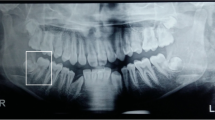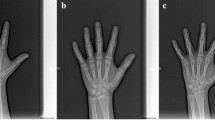Abstract
Purpose
The aim of this study was to comparatively evaluate hand–wrist bones, cervical vertebrae and tooth development stages according to skeletal classification.
Methods
The orthodontic initial records of 297 patients were used and separated into three groups according to the skeletal malocclusion. Three groups including 99 people each were sampled representing malocclusions with Angle classes I, II and III, respectively. The panoramic, cephalometric and hand–wrist radiographs of all patients included in this study were used to compare dental and skeletal maturation indicators. Calcification of teeth was rated according to the system of Demirjian. To evaluate the stage of skeletal maturation hand–wrist radiographs were analyzed according to the Grave and Brown method. Also, Hassel and the Farman method was used to classifying vertebral developmental stages. Spearman rank correlation tests, as well as Fisher exact χ2 tests with r×c tables, were used for the comparison of categorical variables.
Results
Hand–wrist, vertebral and dental development stages showed a statistically significant relationship (p < 0.01) for both genders and in all malocclusions. The association between the different maturation indicators used in this study and the type of malocclusion was also statistically significant for both genders. It was observed that the peak period of skeletal maturation according to the hand–wrist radiograph findings correlated with the cervical vertebrae stage C3 in girls (63.2%) and C2–C3 in boys (43.5–43.5%). The weakest correlation was seen between the dental development stages and the skeletal developmental stages in the class II group (r = 0.443–0.220 [girls]; r = 0.604–0.410 [boys]).
Conclusion
The use of the dental development stage as a reliable indicator of maturation was limited. According to the Demirjian method, the calcification stage of the second molar might indicate that the individual is in the pubertal peak period.
Zusammenfassung
Zweck
Ziel dieser Studie war es, Handwurzelknochen, Halswirbel und Zahnentwicklungsstadien nach Skelettklassifikation vergleichend zu bewerten.
Methoden
Die kieferorthopädischen Erstaufzeichnungen von 297 Patienten wurden verwendet und entsprechend der skelettalen Malokklusion in 3 Gruppen unterteilt. Es wurden 3 Gruppen mit jeweils 99 Personen beprobt, die Angle-Klasse‑I-, -II- bzw. -III-Malokklusionen repräsentierten. Anhand der Orthopantomogramme sowie der kephalometrischen Aufnahmen und der Handwurzelröntgenaufnahmen aller in die Studie aufgenommenen Patienten wurden Indikatoren für die Zahn- und Skelettreifung verglichen. Der dentale Mineralisationsgrad wurde nach dem System von Demirjian bewertet. Zur Beurteilung des Skelettalters wurden Handwurzelröntgenbilder nach der Methode von Grave und Brown analysiert. Ferner wurde die Hassel-Farman-Methode verwendet, um vertebrale Entwicklungsstadien zu klassifizieren. Für den Vergleich kategorialer Variablen wurden Spearman-Rangkorrelationstests sowie exakte Fisher‑χ2-Quadrat-Tests mit R×C-Tabellen verwendet.
Ergebnisse
Handwurzelknochen‑, Wirbelkörper- und Zahnentwicklungsstadien zeigten eine statistisch signifikante Beziehung (p < 0,01) für beide Geschlechter und bei allen Malokklusionen. Der Zusammenhang zwischen den verschiedenen in dieser Studie verwendeten Reifungsindikatoren und der Art der Malokklusion war für beide Geschlechter ebenfalls statistisch signifikant. Es wurde beobachtet, dass die Spitzenzeit der Skelettreifung gemäß den Befunden des Handwurzelknochenröntgenbildes mit dem Halswirbelstadium C3 bei Mädchen (63,2 %) und C2–C3 bei Jungen (43,5–43,5 %) korrelierte. Die schwächste Korrelation wurde zwischen den Zahnentwicklungsstadien und den Skelettentwicklungsstadien in der Klasse-II-Gruppe beobachtet (r = 0,443–0,220 [Mädchen] bzw. r = 0,604–0,410 [Jungen]).
Schlussfolgerung
Die Verwendung des Zahnentwicklungsstadiums als verlässlicher Indikator für die Reifung war begrenzt. Nach der Demirjian-Methode könnte der Mineralisierungsgrad des zweiten Molaren darauf hinweisen, dass sich das Individuum in der Hochphase der pubertären Wachstumsphase befindet.





Similar content being viewed by others
References
Johnston FE, Hufham PH Jr, Moreschi AF, Terry GP (1965) Skeletal Maturation and Cephalofacial Development 1. Angle Orthod 35(1):1–11
Leite HR, O’Reilly MT, Close JM (1987) Skeletal Age Assessment Using the First, Second, and Third Fingers of the Hand. Am J Orthod Dentofacial Orthop 92(6):492–498
Greulich WW, Pyle SI (1959) Radiographic Atlas of Skeletal Development of The Hand and Wrist. Am J Med Sci 238(3):393
Smith RJ (1980) Misuse of Hand-Wrist Radiographs. Am J Orthod 77(1):75–78
Kasımoğlu Y, Tuna-İnce EB (2016) Bone Age Assessment Methods in Dentistry: A Review. Acta Odontol Turcica 33(1):39–46
Hassel B, Farman AG (1995) Skeletal Maturation Evaluation Using Cervical Vertebrae. Am J Orthod Dentofacial Orthop 107(1):58–66
García-Fernandez P, Torre H, Flores L, Rea J (1998) The Cervical Vertebrae as Maturational Indicators. J Clin Orthod 32(4):221–225
Pancherz H, Szyska M (2000) Analyse Der Halswirbelkörper Statt Der Handknochen Zur Bestimmung Der Skelettalen Und Somatischen Reife. Informationen Aus Orthod Kieferorthopädie 32(02):151–161
Coutinho S, Buschang PH, Miranda F (1993) Relationships Between Mandibular Canine Calcification Stages and Skeletal Maturity. Am J Orthod Dentofacial Orthop 104(3):262–268
Krailassiri S, Anuwongnukroh N, Dechkunakorn S (2002) Relationships Between Dental Calcification Stages and Skeletal Maturity Indicators in Thai Individuals. Angle Orthod 72(2):155–166
Kumar S, Singla A, Sharma R, Virdi MS, Anupam A, Mittal B (2012) Skeletal Maturation Evaluation Using Mandibular Second Molar Calcification Stages. Angle Orthod 82(3):501–506
Başaran G, Özer T, Hamamcı N (2007) Cervical Vertebral and Dental Maturity in Turkish Subjects. Am J Orthod Dentofacial Orthop 131 (4):447. e13–20.
Mittal S, Singla A, Virdi M, Sharma R, Mittal B (2009) Co-Relation Between Determination Of Skeletal Maturation Using Cervical Vertebrae and Dental Calcification Stages. J Forensic Sci 4(2):1–9
Baccetti T, Franchi L, Schulz SO, McNamara JA (2008) Treatment Timing For an Orthopedic Approach to Patients with Increased Vertical Dimension. Am J Orthod Dentofacial Orthop 133(1):58–64
Baccetti T, Franchi L, Giuntini V, Masucci C, Vangelisti A, Defraia E (2012) Early Vs Late Orthodontic Treatment Of Deepbite: A Prospective Clinical Trial in Growing Subjects. Am J Orthod Dentofacial Orthop 142(1):75–82
Baccetti T, Franchi L, McNamara JA (2005) In The Cervical Vertebral Maturation (CVM) Method for the Assessment of Optimal Treatment Timing in Dentofacial Orthopedics, Seminars in Orthodontics. Elsevier, , pp 119–219
Ehsani S, Nebbe B, Normando D, Lagravere MO, Flores-Mir C (2014) Short-Term Treatment Effects Produced By The Twin-Block Appliance: A Systematic Review and Meta-Analysis. Eur J Orthod 37(2):170–176
Marsico E, Gatto E, Burrascano M, Matarese G, Cordasco G (2011) Effectiveness of Orthodontic Treatment with Functional Appliances on Mandibular Growth in The Short Term. Am J Orthod Dentofacial Orthop 139(1):24–36
Durka-Zajac M, Derwich M, Mitus-Kenig M, Loboda M, Pawlowska E (2017) Analysis of Dental Maturation in Relation to Sagittal Jaw Relationships. Pol J Radiol 82:32–37
Celikoglu M, Erdem A, Dane A, Demirci T (2011) Dental Age Assessment in Orthodontic Patients with and without Skeletal Malocclusions. Orthod Craniofacial Res 14(2):58–62
Jeelani W, Fida M, Shaikh A (2016) The Duration of Pubertal Growth Peak Among Three Skeletal Classes. Dental Press J Orthod 21(5):67–74
Salazar-Lazo R, Arriola-Guillén LE, Flores-Mir C (2014) Duration of The Peak of Adolescent Growth Spurt in Class I and II Malocclusion Subjects Using a Cervical Vertebrae Maturation Analisis. Acta Odontol Latinoam 27(2):96–101
Kuc-Michalska M, Baccetti T (2010) Duration of the Pubertal Peak in Skeletal Class I and Class III Subjects. Angle Orthod 80(1):54–57
García-Drago AG, Arriola-Guillén LE (2014) Duration of The Peak of Growth in Class I And III Subjects Using the Baccetti’s Cervical Vertebrae Maturation Analysis on Lateral Cephalometric Radiographs. Oral Health Dent Manag 13(4):963–966
Faul F, Erdfelder E, Lang AG, Buchner A (2007) G*Power 3: A flexible statistical power analysis program for the social, behavioral, and biomedical sciences. Behav Res Methods 39:175–191
Grave K, Brown T (1976) Skeletal Ossification and the Adolescent Growth Spurt. Am J Orthod 69(6):611–619
Demirjian A, Goldstein H, Tanner J (1973) A New System of Dental Age Assessment. Hum Biol 45(2):211–227
Perinetti G, Contardo L (2017) Reliability of Growth Indicators and Efficiency of Functional Treatment for Skeletal Class II Malocclusion: Current Evidence and Controversies. Biomed Res Int :1–19. https://doi.org/10.1155/2017/1367691
Perinetti G, Rosso L, Riatti R, Contardo L (2016) Sagittal and Vertical Craniofacial Growth Pattern and Timing of Circumpubertal Skeletal Maturation: A Multiple Regression Study. Biomed Res Int :1–7. https://doi.org/10.1155/2016/1728712
Fishman LS (1979) Chronological versus skeletal age, an evaluation of craniofacial growth. Angle Orthod 49(3):181–189
Lamparski D (1972) Skeletal Age. Assessment (Utilizing Cervical Vertebrae [Master Of Dental Science Thesis]. Pittsburgh: University of Pittsburgh, School of Dental Medicine)
Gandini P, Mancini M, Andreani F (2006) A Comparison of Hand-Wrist Bone and Cervical Vertebral Analyses in Measuring Skeletal Maturation. Angle Orthod 76(6):984–989
Durka-Zając M, Marcinkowska A, Mituś-Kenig M (2013) Bone Age Assessment Using Cephalometric Photographs. Pol J Radiol 78(2):19
O’Reilly MT, Yanniello GJ (1988) Mandibular Growth Changes and Maturation of Cervical Vertebrae:—A Longitudinal Cephalometric Study. Angle Orthod 58(2):179–184
Franchi L, Baccetti T, McNamara JA (2000) Mandibular Growth as Related to Cervical Vertebral Maturation and Body Height. Am J Orthod Dentofacial Orthop 118(3):335–340
Engel TP, Renkema AM, Katsaros C, Pazera P, Pandis N, Fudalej PS (2015) The Cervical Vertebrae Maturation (CVM) Method Cannot Predict Craniofacial Growth in Girls with Class II Malocclusion. Eur J Orthod 38(1):1–7
Willems G (2001) A review of the most commonly used dental age estimation techniques. J Forensic Odontostomatol 19:9–17
Ball G, Woodside D, Tompson B, Hunter WS, Posluns J (2011) Relationship Between Cervical Vertebral Maturation and Mandibular Growth. Am J Orthod Dentofacial Orthop 139(5):455–461
Nestman TS, Marshall SD, Qian F, Holton N, Franciscus RG, Southard TE (2011) Cervical Vertebrae Maturation Method Morphologic Criteria: Poor Reproducibility. Am J Orthod Dentofacial Orthop 140(2):182–188
Leurs IH, Wattel E, Aartman IH, Etty E, Prahl-Andersen B (2005) Dental age in Dutch children. Eur J Orthod 27(3):309–314
Khdairi N, Halilah T, Khandakji MN, Jost-Brinkmann PG, Bartzela T (2019) The adaptation of Demirjian’s dental age estimation method on North German children. Forensic Sci Int 303:1–8
Esan TA, Yengopal V, Schepartz LA (2017) The Demirjian versus the Willems method for dental age estimation in different populations: A meta-analysis of published studies. PLoS ONE 12(11):1–23
Lecca-Morales RM, Carruitero MJ (2017) Relationship Between Dental Calcification and Skeletal Maturation in a Peruvian Sample. Dental Press J Orthod 22(3):89–96
Lopes LJ, de Oliveira Gamba T, Visconti MAPG, Ambrosano GMB, Haiter-Neto F, Freitas DQ (2016) Utility Of Panoramic Radiography for Identification of the Pubertal Growth Period. Am J Orthod Dentofacial Orthop 149(4):509–515
Chertkow S (1980) Tooth Mineralization as an Indicator of the Pubertal Growth Spurt. Am J Orthod 77(1):79–91
Kishore M, Sravya R, Dasari A, Varalakshmi C, Vishal G (2016) Diagnostic Potential of Mandibular Second Premolar and Its Relation to Physiological and Skeletal Maturity in. Girls int J Dent Oral Sci 3(7):291–295
Funding
There is no funding body in the design of the study and collection, analysis, and interpretation of data and in writing the manuscript
Author information
Authors and Affiliations
Corresponding author
Ethics declarations
Conflict of interest
T. Koçak and B. Akan declare that they have no competing interests.
Ethical standards
This research was approved by the Research and Ethics Committee of Izmir Katip Celebi University of Medicine and Health Sciences (Ref. No. 209). Written informed consent to participate was obtained from all participants included in the study.
Additional information
Publisher’s Note
Springer Nature remains neutral with regard to jurisdictional claims in published maps and institutional affiliations.
Supplementary Information
Rights and permissions
About this article
Cite this article
Koçak, T., Akan, B. Assessment of maturation indicators in individuals with different skeletal malocclusion. J Orofac Orthop 82, 187–197 (2021). https://doi.org/10.1007/s00056-021-00286-2
Received:
Accepted:
Published:
Issue Date:
DOI: https://doi.org/10.1007/s00056-021-00286-2
Keywords
- Cervical vertebra
- Demirjian method
- Hand-wrist x‑ray
- Age determination by skeleton
- Orthodontics treatment planning




